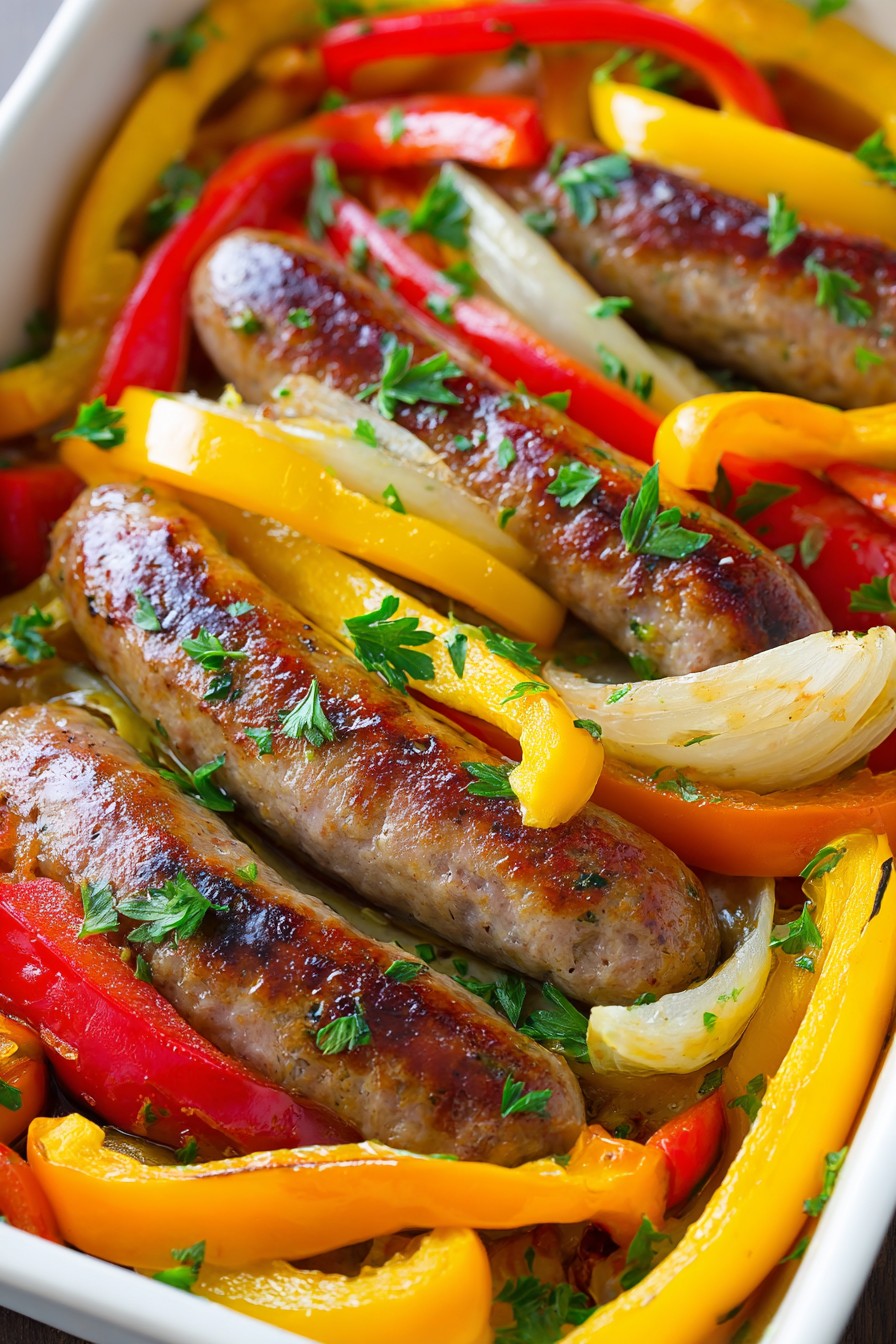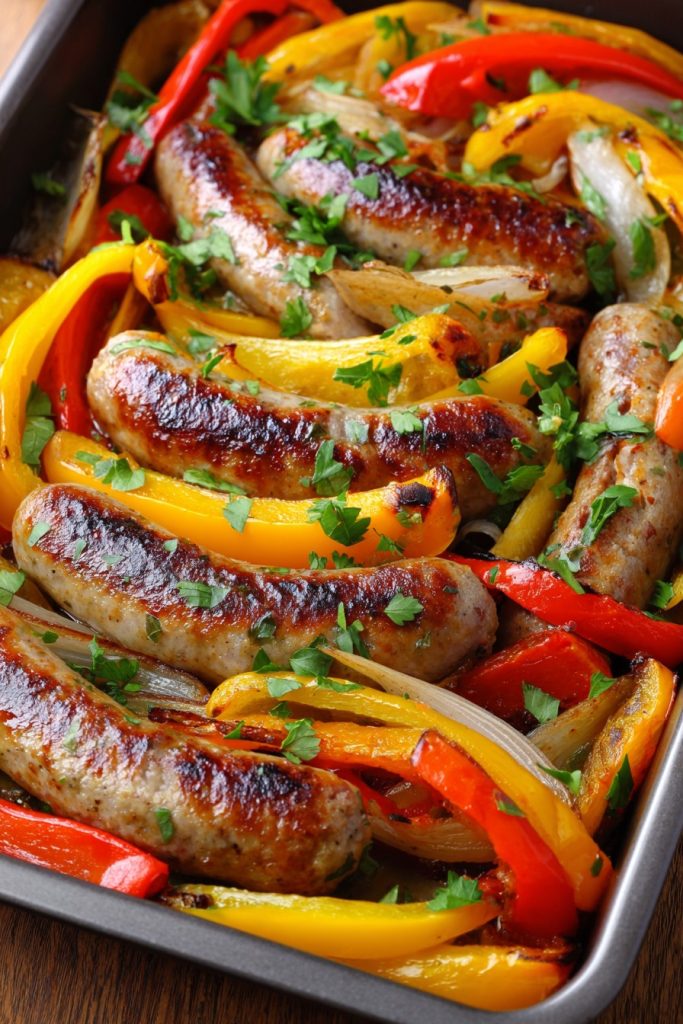Picture this: you’re staring into your refrigerator like it’s a crystal ball that only shows condiments and questionable leftovers. Perfect timing for this glorious one-pan wonder that transforms humble ingredients into a symphony of flavor with minimal effort—because who has time for complicated when hungry is knocking?
Why This Recipe Works
- The oven does all the heavy lifting while you pretend to be a culinary genius—no constant stirring required, just set it and forget it like that infomercial gadget you bought in 2003.
- High heat coaxes out the peppers’ natural sweetness while giving sausage casings that satisfying snap that makes you feel like you actually know what you’re doing in the kitchen.
- Everything cooks together in one pan, creating a glorious flavor party where the sausage juices mingle with vegetables like they’re at a food festival instead of your dinner plate.
- The low-maintenance approach means you can multitask—catch up on your favorite show, scroll through cat videos, or contemplate why we call it “baking” when there’s no flour involved.
- Leftovers taste even better the next day, proving that some relationships (like sausage and peppers) just get better with time, unlike your attempt to grow herbs on the windowsill.
Ingredients
- 1.5 pounds Italian sausage links (sweet, hot, or a dramatic mix of both)
- 3 large bell peppers (red, yellow, and orange for maximum color drama)
- 1 large yellow onion that won’t make you cry too much
- 3 cloves garlic, minced like they owe you money
- 2 tablespoons olive oil (the good stuff, not that mystery bottle from 2018)
- 1 teaspoon dried oregano
- 1/2 teaspoon red pepper flakes (for those who like to live dangerously)
- 1/2 teaspoon salt
- 1/4 teaspoon black pepper
- 1/4 cup chopped fresh parsley for that “I planned this” garnish
Equipment Needed
- Large baking sheet (the bigger, the better—like your appetite)
- Parchment paper or aluminum foil (for easy cleanup, because adulting is hard enough)
- Sharp knife and cutting board
- Mixing bowl
- Tongs (for flipping sausage with theatrical flair)
- Measuring spoons
Instructions

Preheat and Prep Your Veggie Cast
Crank that oven to 400°F—not too hot, not too cold, just the Goldilocks zone for perfect roasting. While it’s heating up, give those bell peppers a starring role by slicing them into generous 1-inch strips, because nobody wants wimpy, thin peppers that disappear into the background. The onion gets similar treatment, sliced into half-moons about 1/4-inch thick—thin enough to caramelize beautifully but thick enough to maintain some structural dignity. Toss these colorful characters with olive oil, minced garlic, oregano, red pepper flakes, salt, and black pepper in a large bowl until they’re evenly coated like they’re preparing for a flavorful photoshoot. Pro tip: Don’t skimp on the oil coating—it’s what prevents your vegetables from turning into sad, shriveled versions of themselves in the oven’s intense heat.
Arrange Your Pan Like a Food Stylist
Line your baking sheet with parchment paper or foil—this isn’t just for easy cleanup, it’s your insurance policy against spending the next hour scrubbing baked-on sausage juices. Arrange the sausage links in a single layer with plenty of breathing room between them; crowding leads to steaming rather than proper browning, and we’re here for that beautiful caramelization, not pale, sad sausages. Scatter the seasoned pepper and onion mixture around and between the sausages in an even layer, creating a colorful mosaic that would make any food photographer swoon. Make sure everything has space to roast properly—if your pan looks like a subway at rush hour, you need a bigger pan or less ambitious dinner plans. The vegetables should nestle around the sausages like enthusiastic groupies at a concert, ready to soak up all those delicious juices.
The Initial Roast and Flip Show
Slide that beautifully arranged pan into your preheated oven and set a timer for 20 minutes—this gives everything time to start getting acquainted while developing those first signs of roasted goodness. When the timer dings, use tongs to flip each sausage link over with the confidence of a grill master; you should see some beautiful browning on the bottom side, a sign that flavor town is just ahead. Give the pepper and onion mixture a good stir at this point too, redistributing them so everything cooks evenly rather than having some pieces turn into charcoal while others remain raw. This flip-and-stir maneuver ensures maximum caramelization on all surfaces and prevents any single ingredient from feeling left out of the flavor party. Watch for the vegetables starting to soften and develop those lovely roasted edges that signal they’re on their way to perfection.
Final Roasting to Perfection
Return the pan to the oven for another 15-20 minutes, during which time magic really happens—the sausages should reach an internal temperature of 160°F (use that meat thermometer you definitely own), while the peppers and onions become tender with beautifully charred edges. The vegetables should be soft enough to cut with a fork but still maintain some texture—nobody wants pepper mush, unless that’s your thing (no judgment). Keep an eye on things during these final minutes; if your sausages are browning faster than the vegetables, you can move them to the top rack temporarily. Pro tip: The sausages are done when they’re evenly browned and firm to the touch, with no pink juices running out when you give them a gentle squeeze with tongs. The peppers should be wilted and slightly wrinkled around the edges, like they’ve just had a very relaxing spa day in your oven.
The Grand Finale and Serving
Remove your masterpiece from the oven and let it rest for about 5 minutes—this allows the sausages to reabsorb their juices rather than spilling them all over the cutting board in a dramatic farewell. Sprinkle the chopped fresh parsley over everything for that pop of color and fresh flavor that makes it look like you actually care about presentation. You can serve this glorious creation as is, slice the sausages into coins and mix everything together, or pile it onto crusty bread for the ultimate sandwich experience. Pro tip: Letting it rest isn’t just for meat—the vegetables continue to soften slightly in the residual heat, and all the flavors meld together into something greater than the sum of its parts. Transfer to a serving platter with all the drama of a cooking show host, because you’ve earned that moment of culinary triumph.
Tips and Tricks
If you’re using fresh sausage rather than pre-cooked, you might need to add an extra 5-10 minutes to the cooking time—just keep checking that internal temperature until it hits 160°F. For extra crispy sausage casings, you can give them a quick sear in a skillet before baking, but let’s be honest, we’re doing the baked version specifically to avoid extra pans. Don’t discard the accumulated juices on the baking sheet—these liquid gold drippings are perfect for drizzling over mashed potatoes, rice, or even soaking into your sandwich bread. If your vegetables are releasing too much liquid during roasting, you can crank up the heat to 425°F for the last 10 minutes to help evaporate excess moisture and improve browning. For meal prep enthusiasts, this dish doubles beautifully and keeps well in the refrigerator for up to 4 days, tasting even better as the flavors continue their happy marriage. If you notice some pieces cooking faster than others, don’t hesitate to rotate your pan halfway through—ovens have hot spots like celebrities have favorite restaurants. For those who like their peppers with more bite, you can add them to the pan during the last 20 minutes of cooking rather than at the beginning. And if you’re feeding a crowd that includes vegetarians, you can substitute plant-based sausages with excellent results—just adjust cooking times according to package directions since they often cook faster than their meaty counterparts.
Recipe Variations
- Turn it into a sheet pan dinner by adding cubed potatoes or sweet potatoes tossed with oil and seasonings—they’ll need a head start of about 15 minutes before adding the other ingredients since potatoes are the divas of the vegetable world that need extra time in the spotlight.
- Create an Italian feast by adding sliced mushrooms, zucchini, or cherry tomatoes during the last 15 minutes of cooking—these moisture-rich vegetables would turn to mush if added too early, so timing is everything like in a good romantic comedy.
- Make it creamy by stirring in 1/2 cup of heavy cream or marinara sauce during the last 10 minutes of baking—this creates a luxurious sauce that clings to every ingredient, turning your simple bake into something worthy of a fancy restaurant menu.
- Go global with different sausage varieties like chorizo for Spanish flair, kielbasa for Eastern European vibes, or chicken apple sausage for that sweet-savory combination that makes your taste buds do a happy dance.
- Add a grain by serving it over cooked polenta, rice, or quinoa to soak up all those delicious pan juices—because letting good flavor go to waste is practically a culinary crime.
Frequently Asked Questions
Can I use frozen peppers instead of fresh?
While frozen peppers will work in a pinch, they release significantly more water during cooking, which can prevent proper browning and turn your beautiful roast into a steam bath. If you must use frozen, thaw them completely and pat them dry with paper towels until they’re no longer weeping moisture. You might also need to increase the cooking temperature during the last 10 minutes to help evaporate excess liquid and achieve some caramelization. The texture will be softer than with fresh peppers, but the flavor will still be there—just don’t expect those beautiful charred edges that make this dish so visually appealing.
How do I know when the sausages are fully cooked?
The most reliable method is using a meat thermometer inserted into the thickest part of the sausage—it should read 160°F for pork sausages. If you’re thermometer-less (which, honestly, you should fix), look for sausages that are firm to the touch and evenly browned with no pink juices running out when pierced. The casings should be taut and slightly crispy in spots, and the internal color should be consistent without any raw-looking areas. Remember that size matters here—thicker sausages will need more time than slender ones, so adjust your cooking time accordingly rather than blindly following the recipe clock.
Can I make this ahead of time for meal prep?
Absolutely! This dish actually improves after a day in the refrigerator as the flavors continue to meld together in harmonious deliciousness. Store it in an airtight container for up to 4 days, and reheat gently in the oven at 350°F or in a skillet over medium heat to maintain texture. Avoid microwaving if possible, as this can make the sausages rubbery and the vegetables mushy—unless you’re into that texture, in which case, you do you. The peppers and onions might release additional liquid upon reheating, which you can either incorporate as a sauce or cook off by increasing the heat at the end.
What’s the best way to serve baked sausage and peppers?
The beauty of this dish is its versatility—you can serve it as is with crusty bread to soak up the juices, over pasta or polenta for a heartier meal, or piled into hoagie rolls for the ultimate sandwich experience. For a low-carb option, serve it over cauliflower rice or zucchini noodles, or simply enjoy it as a standalone dish with a side salad. Leftovers make fantastic pizza toppings, omelet fillings, or additions to fried rice—this is one of those dishes that keeps giving long after the initial meal is over.
My vegetables are burning before the sausage is cooked—help!
This common oven drama usually means your heat is too high or your vegetables are cut too small. Try reducing the temperature to 375°F and giving everything more space on the pan—crowding leads to steaming, but too much space can cause edges to burn. You can also tent the vegetables with foil partway through cooking if they’re browning too quickly, or add them to the pan later in the cooking process. Another trick is to place the sausages directly on the pan but keep the vegetables in a separate oven-safe dish if they continue to be problematic divas.
Summary
This baked sausage and peppers recipe transforms simple ingredients into a flavor-packed masterpiece with minimal effort. The oven does all the work while you reap the rewards of tender vegetables and perfectly cooked sausage. Customizable and crowd-pleasing, it’s weeknight dinner perfection that tastes even better as leftovers.
Baked Sausage and Peppers
6
servings15
minutes35
minutesIngredients
Instructions
- 1 Preheat oven to 400°F
- 2 Toss peppers, onion, and garlic with oil and seasonings
- 3 Arrange sausages and vegetables on parchment-lined baking sheet
- 4 Bake for 20 minutes, then flip sausages and stir vegetables
- 5 Bake additional 15-20 minutes until sausages reach 160°F internally
- 6 Rest 5 minutes, garnish with parsley, and serve



